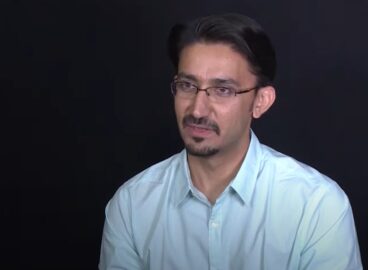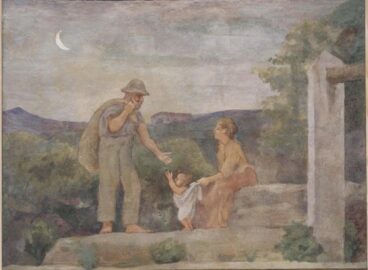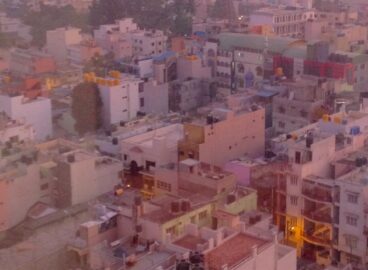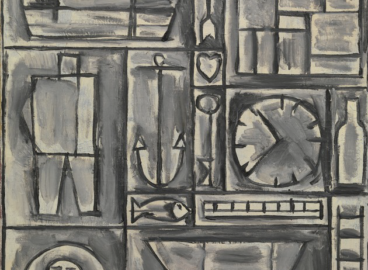Curator Luis Pérez-Oramas considers the roots of the classicizing and modernist impulses in the work of Joaquín Torres-García. The essay examines a driving paradox of the artist’s work–the will to be modern while working against the grain of modernity–following episodes in his life, writings, and works. This is the second part of three.
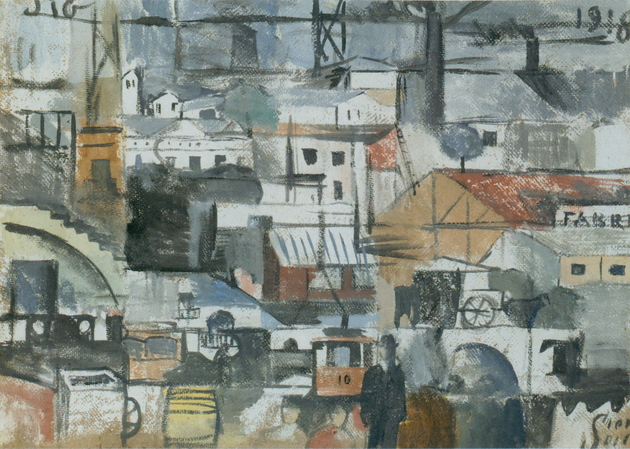
Torres’s first modern scenes shed light on his last years in Barcelona. They were nearly contemporaneous with Lo temporal no és més que símbol, the last Sant Jordi fresco that he was able to complete. This painting of a giant Pan or satyr, rising with his flute above a dancing crowd, is one of the most enigmatic in Torres’s entire corpus.
The first three frescoes had conformed to a rational allegorical order, following a Raphaelesque model in which well-proportioned figures framed an Arcadian landscape. Displacing this Parnassian golden mean, a giant faun now fills the entire visual field. Surpassing the rational, this sublime flute player is a pure figure of the imagination, who uses music to rule a universe of bodies jumbled together in struggles and embraces. The people at the feet of this musical monster evoke Lucretius’s lines on dreaming in De Rerum Natura: “the minds of mortals which perform/With mighty motions mighty enterprises/Often in sleep will do and dare the same . . . /And after sleep, as if still mad in mind/They scarce come to, confounded as they are/By ferment of their frame.”1Lucretius, De Rerum Natura, first century b.c., trans. William Ellery Leonard, 1916, available online at www.perseus.tufts.edu/hopper/text?doc=Perseus%3Atext%3A1999.02.0131%3Abook%3D4%3Acard%3D962 (accessed May 25, 2015).
This monumental creature might remind us of some of Picasso’s 1920s paintings of enormous figures, whose size—but for their morning sunniness and lyricism—might in turn recall the famous Coloso (Colossus, 1808–12) attributed to Goya or a follower.2See Sureda, Torres-García. Pasión clásica, p. 148. In that image as in Torres’s fresco, a giant dominates a crowd with sovereign indifference: there a monstrous beast, here a cosmic musician who sets the melody and rhythm of human experience and labor. As in El Coloso, the monster is an animal in human shape—a faun, an archaic Arcadian creature, barely emerged from its animal origins. Indeed Torres’s preparatory drawings for the fresco include a quick sketch in which he replaced the faun with an ape playing the double bass.
The ape, the faun: primary beings, animals that intimate and prefigure the human. Curiously, the ape also appears on the cover of one of Torres’s most important manuscripts of the period, Hechos (Facts, 1918), the text in which he underwent his “modern conversion.” The faun for its part is a protective figure of pastoral Arcadia, attuned to the rhythms of nature and offering up the fruits and promises of a golden age. It is also an oracle, a Dionysian bearer of prophecies—a bearer of the future—in the form of revelations and dreams, as in Lucretius’s poem. At the bottom of Torres’s strange scene, between two figures personifying Melancholia, is an inscription excerpted from the Chorus Mysticus of Goethe’s Faust: “Lo temporal no és més que símbol,” the temporal is no more than symbol.3Goethe’s German reads, “Alles Vergängliche/Ist nur ein Gleichnis.” The Chorus Mysticus is this book-length poem’s eight-line conclusion.Torres probably first encountered this verse indirectly: the priest Torras i Bagès had done a “Thomist” Christian exegesis of it, and d’Ors had cited it in several Noucentista publications.4See Sureda, Torres-García. Pasión clásica, p. 150 ff. It may be revealing that Torres often misremembered the phrase, repeating it as “Reality is nothing more than symbol.” See, e.g., his autobiography: Torres, Historia de mi vida, p. 176. Considered heretical by some Catholics, the phrase would produce the first controversies around the murals, but it is interesting to us because it indexes a foundational gesture of Torres’s aesthetic: a nonprogressive temporality. Time, as symbol, would for this artist be no more than a convention.
According to Maurice Merleau-Ponty, “Linguists . . . say that since there is strictly no means of marking the date in history when, for example, Latin ends and French begins, there is only one single language and almost only one single tongue unceasingly at work. Let us say more generally that the continued attempt at expression founds one single history, as the hold our body has upon every possible object founds one single space.”5Maurice Merleau-Ponty, Signes (Paris: Gallimard, 1960), p. 87, Eng. trans. as Signs, trans. Richard C. McCleary (Chicago: North-western University Press, 1964), p. 70. Torres similarly sought to compress all the temporal and stylistic fractures, the superficial and formal aspirations, the different languages, styles, obsessions, automatisms, and “truisms” apparent in the work of the historical avant-gardes, into a single stylistic temporality. He intuited a single history and a single language, its unity, uniqueness, and singularity grounded by that anonymous rule. He would confront these fractures with his stoic resistance to the new, his schematic impulse, his pre-historic, Arcadian knowledge.
“The temporal is no more than symbol”: the temporal, the panoply of styles that signify within the fractures of language, is just a glaze of convention and symbol over a single, always incomplete body whose modern form Torres examines. This body constitutes “one single tongue unceasingly at work,” a group of symbolic forms in continual operation, in continual historical action. The unity of incessant, inexhaustible, always unfinished expression grounds the possibility of a universal history, and therefore the possibility of a community within that history, just as the projection of the human body—or of the huge body of Pan in Torres’s fresco—grounds one single space.
That gigantic body—perhaps damaged or ill formed—rises above the various other, smaller bodies in the painting and makes its own organic bodily breath the source of an unexpected music. Perhaps, as temporal symbol, Torres-García’s musical Gulliver prefigures a utopia of stylistic unity, or, rather, the utopian project of a schematic and eventually totalizing compression—a project in which the vast variety of styles that constantly divide us, the various and multiple temporalities of the symbol, will one day be united. As Torres wrote in an undated note, “The law of unity is: what is many ends up as one . . . the many colors end up as one through their tonality. Being within the tone, they are in unity. Forms—within the geometric plane—end up as one thing.”6Torres-García, Anotaciones sobre arte masónico y esotérico. Mapa sintáctico. N.p. The Getty Research Institute, Los Angeles, accession no. 960087.
This giant, then, this monster singing its silent truths, this temporal symbol, this oracle of the future, is an initiatory figure in Torres-García’s work. For the moment, though, it will be sufficient to listen hard enough to hear behind his music, clashing with the serene Noucentista Arcadia, the sounds of the city outside, about to wake up to its modern frenzy.

The portrayal of that modern frenzy began to appear in Torres’s work shortly before he met Barradas. According to Torres’s appointment book, this Uruguayan Vibrationist (Futurist) painter first visited him at Mon Repòs on August 27, 1917.7See Pilar García-Sedas, Joaquín Torres-García y Rafael Barradas. Un diálogo escrito: 1918–1928 (Barcelona: Parsifal Ediciones, 2001), p. 61. Yet a drawing showing an orthogonal network of scenes, a fully “Torresian” structure, accompanied one of his articles in the journal Un enemic del poble (An enemy of the people) in June of that year, while a painting like Figura con paisaje de ciudad (Figure with urban landscape, 1917) is dated June 20.8On these beginnings see Mario Gradowczyk, Torres-García: utopía y transgresión (Montevideo: Museo Torres García, 2007), p. 52 ff. Later works such as Composición vibracionista (Vibrationist composition, 1918), in which the verticality of the murals melds in a proto-Cubist conglomerate, seem to display the effects of the encounter between Torres and Barradas.9On the “intertwining” of “Greek” and “Vibrationist” styles in Torres’s work of these years see Llorens, “Torres-García: a les seves cruïlles,” p. 25. In any event, in an article published in Montevideo in November 1917, Torres described Barradas as a painter “who is searching on his own for what is exciting about reality.” The description echoes his own declaration of purpose at the beginning of 1917: “To make our path on our own; each one of us to be a path.”10See García-Sedas, Joaquín Torres-García y Rafael Barradas, p. 77. Going beyond the attribution of any assessments or isms to Barradas’s work, Torres adds, “I would simply say that he is a painter of the present moment.”11Ibid., p. 62.
A few months earlier, Torres himself had been the artist of an absent moment, an Arcadian illusion, a metaphysical and idealized morning time. Now he discovered the clamor of the present, which was actually already deafening. In Barcelona the political climate was tense; there had been a general strike throughout Spain in 1917, and conflicts would continue to simmer until they exploded in 1919.12See Sureda, Torres-García. Pasión clásica, p. 154. Ten difficult years had passed since the Setmana Tràgica (Tragic week) of 1909, when violent revolt had led to fatalities and ultimately the fall of the Spanish government. Since then, the death rattle of World War I had sounded throughout Europe; Spain had been neutral in the war, but Torres, Barradas, and the larger community saw its effects in the form of refugees and diaspora. In 1918, writing from Barcelona to Barradas in Madrid, Torres, always blunt, remarked, “Tell me about things there. From here, the void, there is nothing left to think anymore.”13Torres-García, letter to Rafael Barradas, August 28, 1918, in García-Sedas, Joaquín Torres-García y Rafael Barradas, p. 133. He would soon go into exile in New York.
It was through Torres’s relationship with Barradas—a friendship prematurely interrupted by the younger artist’s death, at the age of thirty-nine, in 1929—and also through an epistolary friendship with the Spanish poet and critic Guillermo de Torre, leader of the Ultraist movement, that Torres saw a clear possibility for an art of the present moment. In the paintings he made in Barcelona just before leaving for New York, a series of signs and figures emerged that would persist in his art until the end of his career, independent of changes in style—independent of the doctrine of the Taller Torres-García, of Constructivism, of the Escuela del Sur (School of the South), of his constant, surprising returns to previous forms. These signs include the windowed façades that presage the structure of his constructive paintings, the carriages with axle wheels that recall primal signs, clocks marking time, bottles, streetcars, and words and numbers added to the visual field like palimpsests.
It was also during these years that Torres began to make toys, to critical acclaim and with the promise of commercial profit. He told Barradas, “I am excited to be working again, after such a long time of not painting anything. The toys are leading me to this. Because the one is the same as the other. In the end, I think I will have found something that, despite making money—if it actually does—will make me happy to do it. It’s all toys and painting!”14Torres-García, letter to Barradas, December 13, 1918, in ibid., p. 148.
“Because the one is the same as the other”: this unequivocal declaration, made even before Torres established a New York toy business under the brand name “Aladin,” clarifies his artistic impulse. Besides being a source of pleasure in those times of tragedy and war, poverty and hardship, toys were “the same as the other”: that is to say, they responded to the same artistic impulse, the same kind of formal investigation, as painting. And might we not then wonder about the tropes of infancy in Torres’s art as he was moving beyond his Arcadian portrayals of the world’s infancy? Might not these schematic, understated, transformable toys be a modern form of that infancy—vibrating and vibrant like the city, with its noise, its crowds, its multiple overlaid traces—recently awoken from dream in the aftermath of the music of the giant faun in the Sant Jordi fresco?
Torres’s love of toys is an early sign of his destiny—or vocation—as an object-maker, of his work in sculpture, friezes, steles, and furniture. His toys were figures of infancy made by an artist fascinated by the infancy of forms. They also marked the infancy of his sculptural practice, and as such would lead to a number of similarly anthropomorphic works. We will return to these works, since they reveal, more clearly than many others, the primal schematic representation that came to form his language and constructive style.15See Cecilia de Torres, “From Man in the Street to Universal Man,” in Mari Carmen Ramírez, Joaquín Torres-García: Constructing Abstraction with Wood (Houston: The Menil Collection, 2011), pp. 84–91.
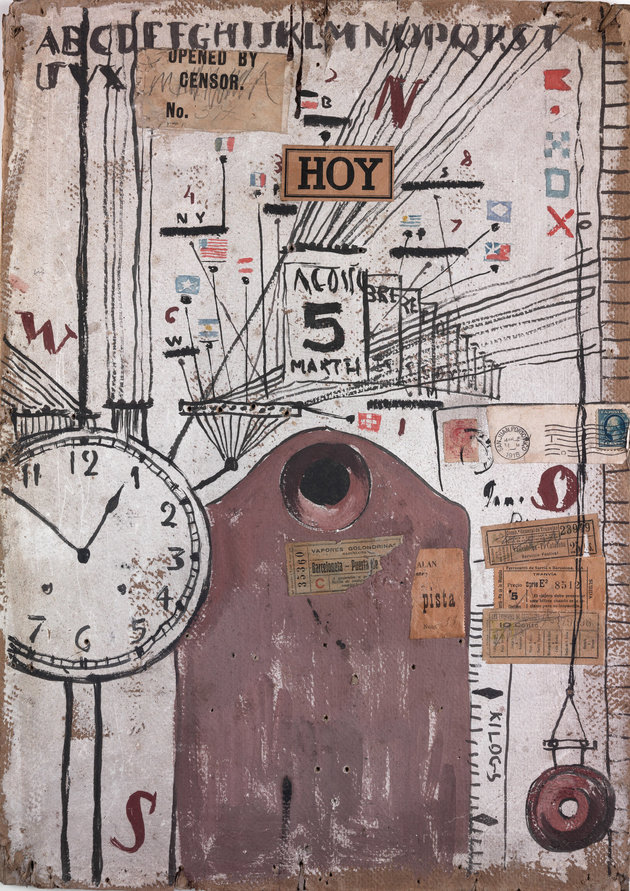
A work meaningfully titled Hoy (Today, c. 1919)—itself an object, a modern stele at the same time that it is a collage—suggests a farewell to Europe on Torres’s part and presages his New York adventure. The many interweaving cables of that city on the Atlantic are already visible, and a compass appears through a marking of the cardinal points. Prefiguring what is to come, a small inscription attached to a tiny American flag reads “NY.” Collage elements—fragments of newspaper and mail, tickets for trains and ships, all evoking displacement and travel—mix English, Spanish, and Catalan. Made just as Torres’s voyage to America marked the close of the first stage of his life, Hoy is his quintessential work of the present moment, of which it forms a repeating image—an image both of the day slipping by and of what Torres called the “man who passes by.”16See Torres-García, “L’art en relació amb l’home etern i l’home que passa,” in Joaquim Torres-García. Escrits sobre art (Barcelona: Edicions 62, 1980), pp. 206–23. The clock marks the hours, and the calendar under the work’s inscribed title indicates the date of that “today”: Tuesday, August 5, 1919.
After a stop in Paris in May of 1920, where he visited Joan Miró and had a brief, disappointing encounter with Picasso, Torres disembarked in New York, where he would live for the next two years.44 In his book New York. Impresiones de un artista (New York: Impressions of an artist, 1921), a kind of instinctive and contradictory conversation with himself, his disillusionment is already apparent:
“This is New York—the city of seven million people—which crushes the artist. —But New York is New York—one of a kind. —When viewed from the Brooklyn Bridge, through the thousand cables that hold up the immense bridge over the East [River]—beneath it, primitive New York—beyond it, eminent, the lofty skyscrapers of City Hall and Wall Street—the center of business, of shops, the soul of New York—and below, the countless ships plowing across the turbid river—and all around, the overwhelming, deafening rush of a thousand vehicles—cars, trucks, streetcars, carts. —And further off, another gigantic bridge, even bigger—with another level on top of it—and another, bigger, even—and others. —And, on the other side—under the river—imagine the subway tunnels—transporting millions of people.” 17J. Torres-García: New York, p. 75. This book contains a facsimile of New York. Impresiones de un artista, as well as Fló’s essay.
This is the descriptive, snowballing tone of Torres-García’s work in New York. He was an adult facing an infinite youthfulness whose message was clear: the modern century that he had portrayed in his early Catalan days was not the real modern century, the site of its true intensity; that was this great city, which disturbed and challenged him. But neither was New York the place where his definitive voice would be formed. In many works a fascination with the scene prevails over an interest in structure. In New York, Torres discovered what it is to look down from above; he was fascinated with the bird’s-eye view, from skyscrapers or from the sky. A series of collages he kept in his archive shows the variety of his approaches to life in New York, from Broadway shows—for which he drew advertisement illustrations—to a totalizing aerial view of the city. Nor can we forget his equally ironic approach to the cultures of consumption and of the avant-garde, as when he juxtaposed fashion advertisements for women with Cubist clothes.
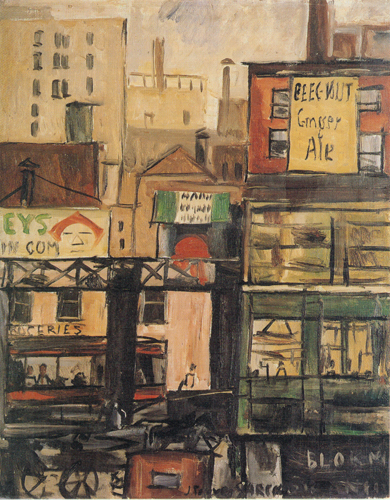
Torres’s absorption of the modern art he saw in New York is obvious in both the subject matter and the visual structure of his work: a late adoption of Cubist and Dadaist strategies leads to a juxtaposition of signs and planes of color, while an interest in the urban scene can be related to such artists as Stuart Davis, Charles Demuth, John Marin, Max Weber, and others. The city and its facades as seen from the street—an interest of Torres’s early on, at the beginning of the century, when he witnessed part of the construction of Barcelona’s Eixample neighborhood—gave him some of his best works of these years: out of the chaotic disorder of the urban complex emerged structures of orthogonal lines within whose compartments appeared an array of urban figures—people, bridges, windows, advertisements, inscriptions, tanks, roofs, streetcars. Once symbols replaced real things in those compartments, once the painting became indifferent to local atmosphere, once structure moved from the urban background into an explicit organizing optic, Torres would have arrived at his method—but this would not happen until 1929. Torres met more than a few significant players on the New York scene: Davis, Katherine Dreier and her sister Dorothea, Walter Pach, Joseph Stella, Alfred Stieglitz, Edgard Varèse, Max Weber, Gertrude Vanderbilt Whitney. Yet although he exhibited and to a lesser extent sold his works in New York, his time in the city would end with a hasty return to Europe. For all the grand galas he attended—for one of which he designed a famous suit, overalls à la Rodchenko that made the city material on his body—the disappointment, even the failure, of his time in America is clear in a photograph of him wearing this suit, and perched on his bed, disguised as a “human ad, a decoy.” Juan José Lahuerta writes of this image:
“Contrary to those who imagine Torres-García as a regular guest at the parties of millionaire New York collectors, we find this sad photo, taken in the narrow corner of a bedroom decorated with drab wallpaper, with a simple armoire, and finally (can’t you see it?) Torres appears perched on a bed atop whose mattress he has taken the extreme precaution of laying a plank. This strange pedestal speaks to us of the miseries of art, of the tremendous gap between his reality and his aspirations, his means and his ends, of his comic willfulness.”18Juan José Lahuerta, “Disfraz, madera,” in Guigon et al., Joaquín Torres-García (1874–1949), pp. 184–86.
Torres’s New York notebook—and probably also his experience in that human archipelago—ends in sadness and resignation:
“I am the poor man—unassuming, long-suffering, uncomplaining. —I am fine here in New York and everywhere. —I am not a pessimist—but I prefer to think that everything will go badly, that everything is fragile. —I prefer small houses to palaces—a clay pot—a pine table— Working, that’s my only pleasure in life—and I don’t think there is any other. —I live in peace with my wife and my children. —I live in peace with my neighbors—and I have nothing to say, neither good nor bad, about this great city of New York. —It would be the same to me to live elsewhere, among other people. —Because I look more inside myself than outside. —I have been lost for a long time, and this has made me suffer greatly, but now I have found the path. —The real world exists inside each one of us, —not outside.”19Torres-García, New York, p. 151.
This is the second section of the essay. Read the first part here and the third and final part here. Excerpted from Luis Pérez-Oramas’s essay “The Anonymous Rule: Joaquín Torres-García, the Schematic Impulse, and Arcadian Modernity” in the exhibition catalog Joaquín Torres-García: The Arcadian Modern available at the MoMA Design Store and online.
- 1Lucretius, De Rerum Natura, first century b.c., trans. William Ellery Leonard, 1916, available online at www.perseus.tufts.edu/hopper/text?doc=Perseus%3Atext%3A1999.02.0131%3Abook%3D4%3Acard%3D962 (accessed May 25, 2015).
- 2See Sureda, Torres-García. Pasión clásica, p. 148.
- 3Goethe’s German reads, “Alles Vergängliche/Ist nur ein Gleichnis.” The Chorus Mysticus is this book-length poem’s eight-line conclusion.
- 4See Sureda, Torres-García. Pasión clásica, p. 150 ff. It may be revealing that Torres often misremembered the phrase, repeating it as “Reality is nothing more than symbol.” See, e.g., his autobiography: Torres, Historia de mi vida, p. 176.
- 5Maurice Merleau-Ponty, Signes (Paris: Gallimard, 1960), p. 87, Eng. trans. as Signs, trans. Richard C. McCleary (Chicago: North-western University Press, 1964), p. 70.
- 6Torres-García, Anotaciones sobre arte masónico y esotérico. Mapa sintáctico. N.p. The Getty Research Institute, Los Angeles, accession no. 960087.
- 7See Pilar García-Sedas, Joaquín Torres-García y Rafael Barradas. Un diálogo escrito: 1918–1928 (Barcelona: Parsifal Ediciones, 2001), p. 61.
- 8On these beginnings see Mario Gradowczyk, Torres-García: utopía y transgresión (Montevideo: Museo Torres García, 2007), p. 52 ff.
- 9On the “intertwining” of “Greek” and “Vibrationist” styles in Torres’s work of these years see Llorens, “Torres-García: a les seves cruïlles,” p. 25.
- 10See García-Sedas, Joaquín Torres-García y Rafael Barradas, p. 77.
- 11Ibid., p. 62.
- 12See Sureda, Torres-García. Pasión clásica, p. 154.
- 13Torres-García, letter to Rafael Barradas, August 28, 1918, in García-Sedas, Joaquín Torres-García y Rafael Barradas, p. 133.
- 14Torres-García, letter to Barradas, December 13, 1918, in ibid., p. 148.
- 15See Cecilia de Torres, “From Man in the Street to Universal Man,” in Mari Carmen Ramírez, Joaquín Torres-García: Constructing Abstraction with Wood (Houston: The Menil Collection, 2011), pp. 84–91.
- 16See Torres-García, “L’art en relació amb l’home etern i l’home que passa,” in Joaquim Torres-García. Escrits sobre art (Barcelona: Edicions 62, 1980), pp. 206–23.
- 17J. Torres-García: New York, p. 75. This book contains a facsimile of New York. Impresiones de un artista, as well as Fló’s essay.
- 18Juan José Lahuerta, “Disfraz, madera,” in Guigon et al., Joaquín Torres-García (1874–1949), pp. 184–86.
- 19Torres-García, New York, p. 151.
